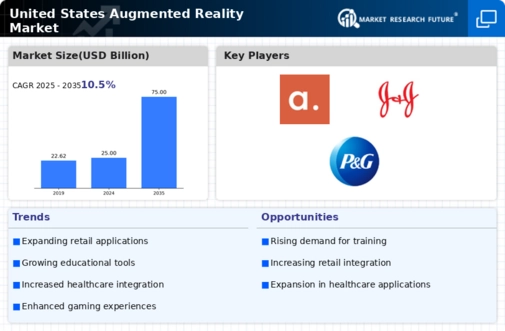Increased Investment in AR Startups
Investment in augmented reality startups is on the rise, indicating a robust interest in the potential of this technology. Venture capital funding for AR companies has seen a notable increase, with investments reaching over $1 billion in 2025 alone. This influx of capital is likely to foster innovation and accelerate the development of new applications across various sectors, including entertainment, retail, and real estate. As more startups enter the augmented reality market, competition will intensify, leading to enhanced product offerings and potentially lower prices for consumers. This dynamic environment is expected to stimulate further growth in the augmented reality market.
Technological Advancements in Hardware
The augmented reality market is experiencing a surge in technological advancements in hardware, which is likely to enhance user experiences significantly. Innovations in devices such as AR glasses and headsets are becoming more sophisticated, offering improved graphics and processing capabilities. For instance, the introduction of lightweight, high-resolution displays is making AR applications more accessible and appealing to consumers. This trend is supported by a projected growth rate of approximately 30% in the hardware segment of the augmented reality market by 2026. As these devices become more affordable and user-friendly, adoption rates are expected to rise, further driving the augmented reality market forward.
Integration of AR in Marketing Strategies
The integration of augmented reality in marketing strategies is becoming increasingly prevalent, as brands recognize its potential to engage consumers in novel ways. Companies are leveraging AR to create interactive advertisements and immersive experiences that captivate audiences. For example, AR applications that allow customers to visualize products in their own environments are gaining traction, leading to higher conversion rates. This trend is reflected in a 20% increase in AR marketing campaigns in 2025 compared to the previous year. As businesses continue to explore innovative marketing techniques, the augmented reality market is likely to benefit from this growing interest.
Expansion of AR in Gaming and Entertainment
The gaming and entertainment sectors are witnessing a significant expansion of augmented reality applications, which is likely to propel the overall market forward. With the increasing popularity of AR games and interactive experiences, consumer engagement is at an all-time high. Major gaming companies are investing heavily in AR technology, with projections indicating that the gaming segment of the augmented reality market could reach $10 billion by 2026. This growth is driven by the desire for immersive experiences that blend the digital and physical worlds, suggesting a promising future for the augmented reality market in entertainment.
Rising Demand for Remote Collaboration Tools
The demand for remote collaboration tools is driving growth in the augmented reality market, particularly as businesses seek innovative solutions to enhance communication and productivity. AR technology facilitates immersive virtual meetings and interactive presentations, allowing teams to collaborate effectively regardless of their physical locations. According to recent data, the market for AR-based collaboration tools is projected to grow by 25% annually through 2027. This trend is indicative of a broader shift towards digital transformation in the workplace, where augmented reality market solutions are becoming essential for maintaining competitive advantage.














Leave a Comment